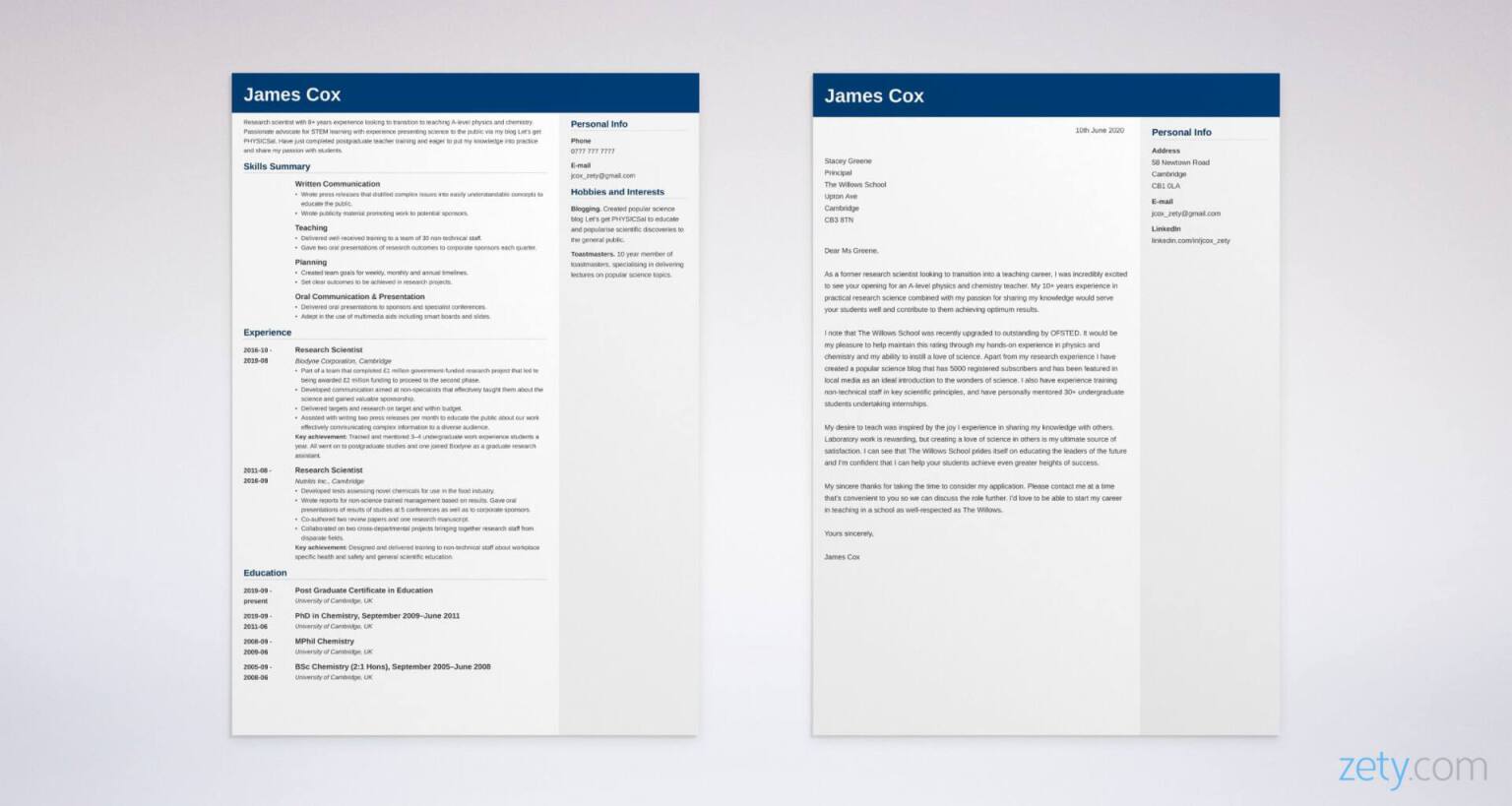Career Change Cover Letter: Sample & 20+ Writing Tips
Create your cover letter nowWhen you’re looking to make a change of career your cover letter becomes particularly important. Taken in isolation, your CV might not contain the direct experience that hiring managers are looking for.
But write a good career change cover letter and you’ll be able to fill in the blanks and show you’ve got the transferable skills to be a prime candidate.
A good cover letter for career change can help you make the transition to the job of your dreams. And in just five minutes, you’re going to learn how to write one.
Read on and this guide will show you free career change cover letter samples that’ll help make writing your own a breeze.
Want to write your cover letter fast? Use our cover letter builder. Choose from 20+ professional cover letter templates that match your CV. See actionable examples and get expert tips along the way.
Career Change Cover Letter for a CV—See more cover letter templates and create your cover letter here.
Let’s get that career move started.
Career Change Cover Letter Sample
James Cox
58 Newtown Road
Cambridge
CB1 0LA
jcox_zety@gmail.com
linkedin.com/in/jcox_zety
10th June 2025
Stacey Greene
Principal
The Willows School
Upton Ave
Cambridge
CB3 8TN
Dear Ms Greene,
As a former research scientist looking to transition into a teaching career, I was incredibly excited to see your opening for an A-level physics and chemistry teacher. My 10+ years experience in practical research science combined with my passion for sharing my knowledge would serve your students well and contribute to them achieving optimum results.
I note that The Willows School was recently upgraded to outstanding by OFSTED. It would be my pleasure to help maintain this rating through my hands-on experience in physics and chemistry and my ability to instill a love of science. Apart from my research experience I have created a popular science blog that has 5000 registered subscribers and has been featured in local media as an ideal introduction to the wonders of science. I also have experience training non-technical staff in key scientific principles, and have personally mentored 30+ undergraduate students undertaking internships.
My desire to teach was inspired by the joy I experience in sharing my knowledge with others. Laboratory work is rewarding, but creating a love of science in others is my ultimate source of satisfaction. I can see that The Willows School prides itself on educating the leaders of the future and I’m confident that I can help your students achieve even greater heights of success.
My sincere thanks for taking the time to consider my application. Please contact me at a time that’s convenient to you so we can discuss the role further. I’d love to be able to start my career in teaching in a school as well-respected as The Willows.
Yours sincerely,
James Cox
You’ve just seen a great career change cover letter example and you’re about to see how to write your own. But remember—
Your cover letter is nothing without a great CV to pair it with. Learn how to write it here: Career Change CV & Writing Guide
And if you’re not quite ready for a career change, we’ve got other cover letter guides too.
- Retail Cover Letter Example & Tips
- Cover Letter for an Internship Example & Tips
- Graduate Cover Letter Example & Tips
- Speculative Cover Letter Example & Tips
- Customer Service Cover Letter Example & Tips
- Graphic Design Cover Letter Example & Tips
- Consulting Cover Letter Example & Tips
- Motivation Letter Example & Tips
- Receptionist Cover Letter Example & Tips
- Sales Assistant Cover Letter Example & Tips
- Architecture Cover Letter Example & Tips
- Teaching Assistant (TA) Cover Letter Example & Tips
- Engineering Cover Letter Example & Tips
Career Change Cover Letter Template
Here’s how to write a career change cover letter.
1. Start with a Professional Career Change Cover Letter Format
A cover letter for career change can be a hard sell. Don’t make it any more difficult for yourself by ruining your first impression with poor formatting. Here’s how to get it right.
- Get everything set up before you start writing. Start off with your page margins and set them to one inch on each side. Then set your line spacing to single or 1.15.
- Next, choose a nice clearly readable font set at 11–12 pts. Trebuchet MS, Tahoma and Arial are classic choices that also make great CV fonts.
- And remember to keep your cover letter length in check, don’t write more than one page.
Read more: Step-by-Step Guide to Cover Letter Format
2. Write Your Career Change Cover Letter Header
Again, make sure you get the basics right here and follow standard UK letter formatting. This is what you need to do.
- Address your cover letter correctly. Your contact details go first and they should be right-aligned. Then leave a space and enter the date using the correct format e.g. 9th June 2025.
- Next, switch to left-alignment and enter the hiring manager’s details. Always try to find out their name and address it to them personally.
How to find out the hiring manager’s name? Just do a little research. Check on LinkedIn to see who’s in charge of the team you want to join or even just call the office and ask. By using the hiring manager’s name you take advantage of a powerful effect that instantly makes them pay more attention to what they’re reading.
Read more: How to Address a Cover Letter
3. Open up with a Personal Greeting and a Compelling First Paragraph
Now it’s time to get writing. The first paragraph of your change of career cover letter needs to be eye-catching and it’s the first step in convincing the hiring manager that you can succeed in your new career.
- Start with a standard formal greeting, Dear [hiring manager’s name]. Don’t use To Whom It May Concern or Dear Sir/Madam, those old chestnuts are far too cold and impersonal. If you don’t have a name then Dear Hiring Manager is your best option.
- In your first paragraph mention the role you’re applying for. It shows you’ve tailored your cover letter to the job and makes your intentions clear.
- Then add a ‘hook’, an impressive professional accomplishment or attribute that shows you’ll make a great employee in your new role.
The trick is to highlight transferable skills and experience. Research the role in detail by looking at the job description, learning about the industry as a whole and about the company you’re applying to.
When you’ve got a clear picture of what’s required then choose experience, skills or achievements that are targetted to your new career.
Pro Tip: Soft skills are particularly important to consider. They’re easily transferable between careers and highly desired by employers in all industries.
Read more: How to Start a Cover Letter
4. Prove You’re an Ideal Candidate for Your New Career
The middle of your career change cover letter is where you really drive home your ability to thrive in your new industry. Use the second paragraph to build on the first, adding even more evidence of your skills and abilities.
- Carefully consider the research you’ve carried out on the role. Compare its demands with your own experience and skills.
- Make sure you consider the entirety of your life experience. Have you done volunteer work or participated in a hobby that’s given you relevant experience? Maybe you’ve got relevant education or training. A cover letter for career change demands you think outside the box.
- And when you’re mentioning achievements and experience always aim to quantify it with numbers and use accomplishment statements. Don’t just say what you did. Prove how well you did it.
5. Show How Much You Want the New Job
The third paragraph of your change of career cover letter should show your passion and commitment to your new career path. Show the hiring manager why you’ve chosen this new career with this company in particular. Here’s how to do it.
- Once again, research and preparation is key. Find out as much as you can about working for the employer and highlight a positive fact that’s motivated you to apply.
- Also, look at their current challenges and future plans and demonstrate how you can contribute (check their LinkedIn or website for details).
By doing this, you’re showing commitment to the employer and selling yourself as a candidate who can make a real contribution to the business.
Read more: How Long Should a Cover Letter Be?
6. End With a Call to Action and Say Thank You
The last paragraph of your career change cover letter should create a strong finish. It’s your opportunity to underline everything that’s preceded it and convince the hiring manager to arrange that all-important interview.
- Always ask the hiring manager to get in touch so you can discuss the role further. This is known as a call to action and it’s proven to increase your chances of success.
- Add a final relevant professional achievement or discuss your career goals. Take this last chance to prove what a committed and productive employee you’ll be.
- Say thank you. It’s good manners of course, but it’s more than that too. Being shown gratitude motivates people, giving another little boost to your job application.
- And one phrase you don’t need to include is ‘please find attached my CV.’ It’s really not necessary and there are much better ways to say it.
Read more: How to End a Cover Letter
7. Nail Your Sign-Off
When it’s time to say goodbye, following standard business formatting is key.
- Sign-off your career change cover letter with your full name and add a digital copy of your handwritten signature for an extra professional touch.
- Write ‘Yours sincerely’ if your letter was addressed to a named person and ‘Yours faithfully’ if it wasn’t, i.e. if you used ‘Dear Hiring Manager’.
- And the rules change slightly if you’re sending your cover letter as the body of an email. In this case, add your contact details to your email signature instead of writing them at the top of the page.
We’ve written this guide as a brief summary of how to write a cover letter for career change. If you’d like a more detailed guide read more here: Complete Guide to Writing a Cover Letter
And one last reminder, your career change cover letter is important, but it always needs a well-written CV to go with it.
When making a CV in our builder, drag & drop bullet points, skills, and auto-fill the boring stuff. Spell check? Check. Start building your CV here.
When you’re done, Zety’s CV builder will score your CV and tell you exactly how to make it better.
Thanks for reading. I hope you’ve enjoyed our guide on writing a cover letter for change of career. If you need any specific advice about your own career change plans please let me know in the comments section and I’ll be happy to help.
About Zety’s Editorial Process
Our editorial team has thoroughly reviewed this article to ensure it follows Zety’s editorial guidelines. Our dedication lies in sharing our expertise and providing you with actionable career advice that offers you real value. Every year, the quality of our content attracts 40 million readers to our site. But that’s not all – we conduct original research to gain a detailed understanding of the labour market. We take pride in being cited by top universities and leading media outlets in the UK and worldwide.





